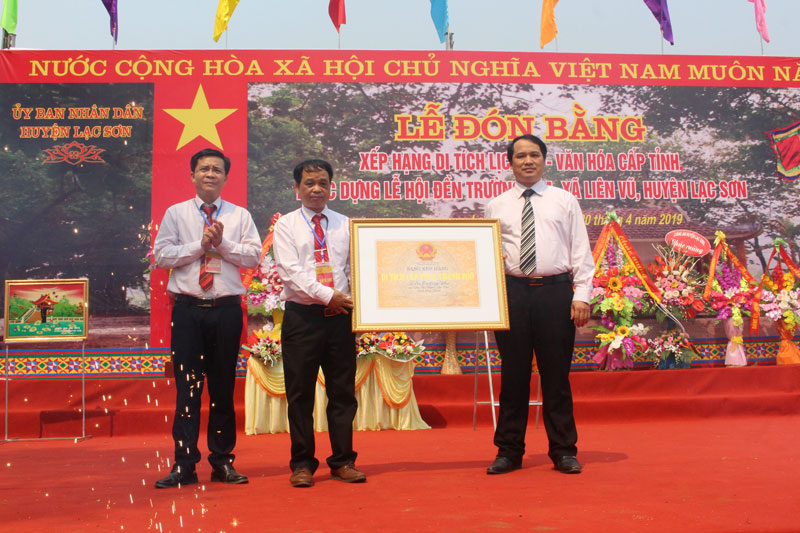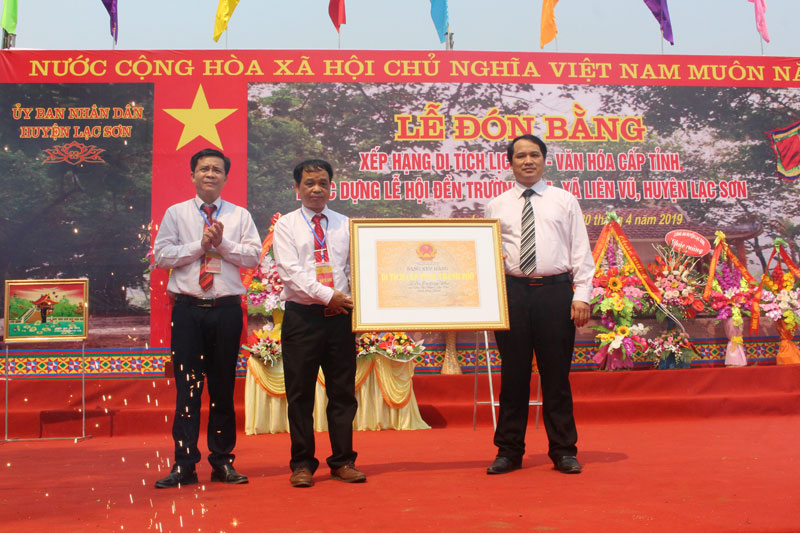
(HBO) - The People’s Committee of Lac Son district in the northern province of Hoa Binh has organised a ceremony to receive a certificate recognising Truong Kha temple in Lien Vu commune (Lac Son) as a provincial cultural, historical relic site.

The ceremony was
also to re-enact the Truong Kha temple festival.
The Truong Kha temple is located in Chieng
hamlet, Lien Vu commune. It was built in the 15th century and restored by
locals in 1997 with roof tiles, a wooden altar arranged with ceramic incense
bowls and some worshipping items.
In 2013, through capital sources mobilised among
individuals and organisations, people in the commune rebuilt the temple on the
foundation of the old one as a place of worshipping. Legend has it that the
Truong Kha temple worshipped three Kun Dol gods who protect rice crops and
cultivation of Muong people and they were worshipped by locals in the ancient Voi
Trao area as tutelary gods.
The Truong Kha temple festival is held annually
on the 15th and 16th day of the third lunar month. It is called bumper-crop praying
festival with rituals such as a procession of the three Kun Dol gods, shooting
white buffalos with Oong Thoong pipe, praying for rain and fishing. Besides,
people could participate in national sports, folk games and art exchanges.
With historical and cultural values, the Truong
Kha temple festival in Lien Vu commune (Lac Son) has been recognised as a
provincial cultural, historical relic site by the provincial People’s Committee
under Decision No.12/QD-UBND./.
With an increasingly vibrant and widespread emulation movement aimed at building cultured residential areas and cultured families, Yen Thuy District has been making steady progress toward improving both the material and spiritual well-being of its people, while fostering a civilized, prosperous, beautiful, and progressive community.
Once lacking recreational spaces and community facilities, Residential Group 2 in Quynh Lam Ward (Hoa Binh City) has recently received attention for the construction of a new, spacious, and fully equipped cultural house. The project followed the model of state support combined with public contributions in both labor and funding.
The "All people unite to build cultural life" movement, which has been effectively integrated with Kim Boi district’s socio-economic development goals, is fostering a lively spirit of emulation across local residential areas, hamlets, villages, public agencies, and enterprises. In addition, through the initiative, traditional cultural values are being preserved and promoted, while community solidarity and mutual support in poverty reduction and economic development are being strengthened.
A working delegation of the Hoa Binh provincial People’s Committee led by its Permanent Vice Chairman Nguyen Van Toan on June 11 inspected the progress of a project to build the Mo Muong Cultural Heritage Conservation Space linked to tourism services in Hop Phong commune, Cao Phong district.
Born and growing in the heroic land of Muong Dong, Dinh Thi Kieu Dung, a resident in Bo town of Kim Boi district, in her childhood was nurtured by the sweet lullabies of her grandmother and mother. These melodies deeply imprinted on her soul, becoming an inseparable part of her love for her ethnic group's culture. For over 20 years, this love for her hometown has driven Dung to research, collect, and pass down the cultural values of the Muong people to future generations.
In the final days of May, the Ethnic Art Troupe of Hoa Binh Province organized performances to serve the people in remote, mountainous, and particularly disadvantaged areas within the province. These were not just ordinary artistic shows, but they were the meaningful journeys aimed at spreading cultural values, enhancing the spiritual life of the people and contributing to the preservation of ethnic minority cultural identities.



